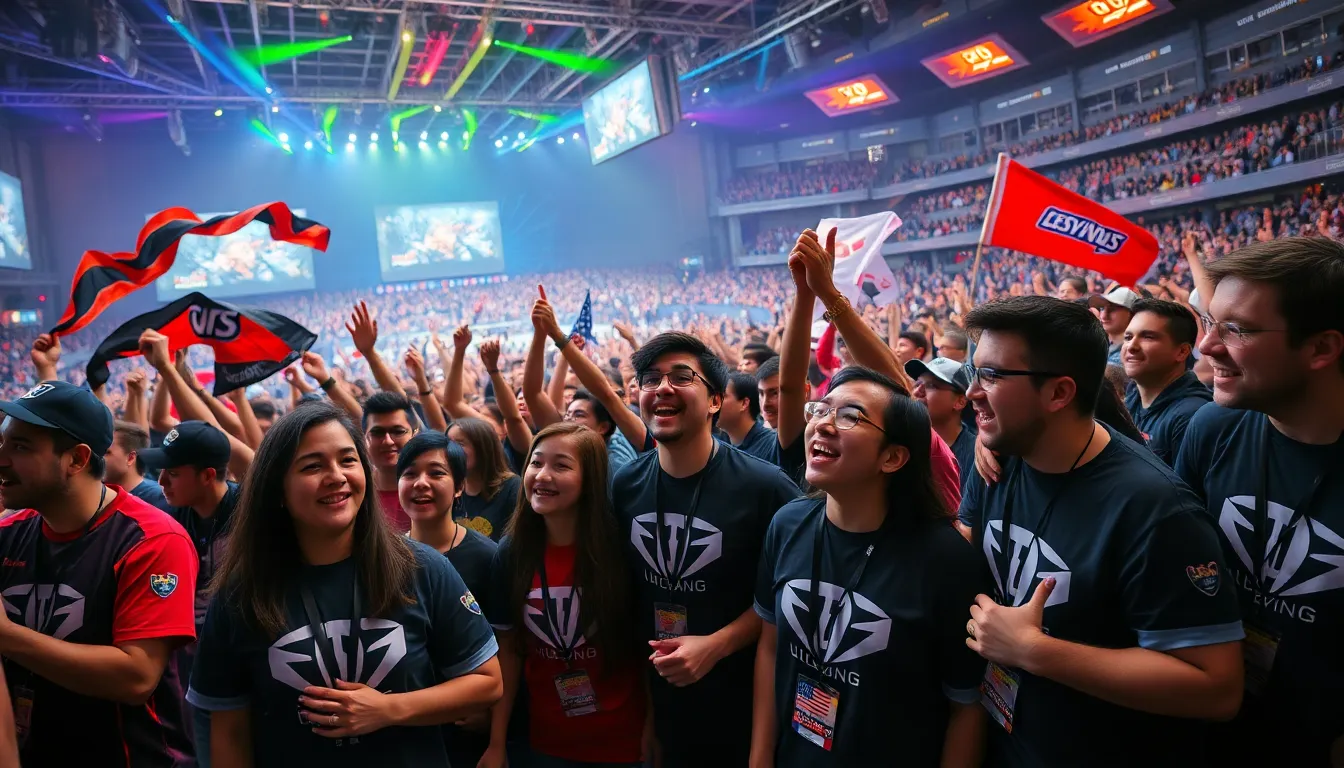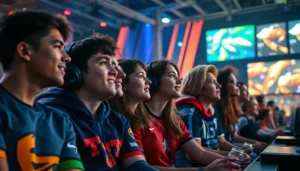In a world where gaming isn’t just a pastime but a lifestyle, the fusion of traditional gaming and esports has become the hottest ticket in town. Picture this: your favorite game morphs into a competitive showdown where players go head-to-head for glory, fame, and maybe a lifetime supply of energy drinks. It’s not just about leveling up anymore; it’s about integrating skills, strategy, and a sprinkle of showmanship to captivate audiences worldwide.
As esports continues to gain traction, the lines between casual gaming and competitive play blur, creating a vibrant ecosystem that’s impossible to ignore. Whether you’re a seasoned gamer or just someone who enjoys the occasional round of Mario Kart, understanding this integration opens up a whole new realm of excitement. Get ready to dive into the thrilling world where pixels meet competition, and discover how this evolution is reshaping the gaming landscape.
Table of Contents
ToggleOverview of Gaming and Esports Integration
Gaming and esports integration represents a significant trend in the entertainment industry. This integration reshapes how individuals perceive gaming, elevating it beyond casual play to a mainstream competitive activity. Players now participate in tournaments that attract millions of viewers across streaming platforms, demonstrating the robust connection between gaming communities and competitive audiences.
Many traditional gaming franchises have embraced esports by developing competitive leagues and events. Titles such as “League of Legends,” “Dota 2,” and “Counter-Strike: Global Offensive” exemplify this shift, transforming from simple games into global phenomena with professional teams and sponsorships. These developments make it clear that players aim for more than just enjoyment; they seek recognition and financial rewards.
Engagement in esports fosters a sense of community among players and fans. Spectator numbers at esports events continuously rise, with some championship finals drawing crowds that rival traditional sports. This enthusiasm showcases the emotional investment in gaming culture, where fans support their favorite teams and players with intense loyalty.
The blending of gaming and esports influences various industries, including tech and fashion. Companies manufacture peripherals specifically designed for gamers, while brands create apparel linked to esports teams. As businesses recognize the potential within this integrated space, collaboration opportunities expand across sectors.
Innovation also drives this integration, with advancements in technology enhancing gameplay and viewer experience. Interactive streaming services and improved graphics contribute to the overall excitement of competitions, solidifying esports as a dominant force.
Overall, gaming and esports integration signals a new era in entertainment, redefining social interactions and economic landscapes through shared experiences.
Benefits of Gaming and Esports Integration

Gaming and esports integration offers numerous advantages that enhance the experience for players and fans alike.
Enhanced Community Engagement
Community engagement thrives with the integration of gaming and esports. Players connect through online platforms, forming strong relationships based on shared interests. Esports events further boost camaraderie, as fans gather to support favorite teams. Streaming platforms create interactive environments, allowing viewers to chat, react, and celebrate in real-time. This interaction fosters loyalty and involvement within gaming communities. Tournaments, often held in large arenas, attract live audiences and bridge the gap between online and offline engagement. Enthusiastic fans elevate the thrill, as they experience the excitement together. Consequently, this vibrant community environment creates lasting friendships among participants.
Economic Opportunities
Economic opportunities expand significantly through gaming and esports integration. Professional players now access sponsorships, generating substantial income. Organizations invest in esports teams, recognizing the potential for brand visibility. Job roles in marketing, content creation, and event management flourish as the market grows. Revenue from merchandise sales also increases, with customized apparel and accessories gaining popularity. Streaming services present unique earning potential for gamers, allowing them to monetize their content. Influencers leverage their platforms to partner with brands, further enhancing economic prospects. Educational institutions even offer scholarships for esports, paving the way for aspiring professionals in the industry.
Challenges in Gaming and Esports Integration
Integration between gaming and esports faces several significant challenges. These obstacles can impact growth and acceptance within the industry.
Regulatory Hurdles
Regulatory challenges pose risks for gaming and esports integration. Various jurisdictions impose different legal frameworks on gaming practices. Compliance with these regulations often proves tricky for developers and organizers. Licensing issues can delay tournament planning and execution. In some regions, legal age restrictions complicate participation for younger gamers. Constantly changing legislation requires organizations to adapt swiftly, impacting overall industry stability. Navigating these complexities often demands resources that smaller entities may lack. Investors seek clarity and safety in an uncertain legal landscape, affecting funding opportunities.
Technological Limitations
Technological barriers hinder seamless integration of gaming and esports. Many gamers encounter performance issues due to varied hardware capabilities. Different internet speeds and connectivity problems create frustrating experiences during competitive play. Streaming infrastructure often falls short, leading to lagging broadcasts and decreased viewer satisfaction. Inconsistent platform capabilities result in unequal opportunities for players. Hardware requirements for high-level gaming can exclude casual players from competitive scenes. Developers face pressure to innovate continually, yet managing compatibility across diverse systems challenges many companies. Addressing these limitations remains crucial for fostering a thriving esports environment.
Successful Case Studies
Major advancements illustrate the effective integration of gaming and esports. Various companies leverage collaborative efforts to enhance their reach and engage diverse audiences.
Notable Partnerships
Brand collaborations have become pivotal in esports. For instance, Intel and ESL have partnered for over a decade, revolutionizing competitive gaming through sponsorship and technology support. Riot Games has teamed up with various brands, sparking innovative in-game collaborations that expand player engagement. These alliances strengthen community connections and increase brand visibility, benefiting both entities. High-profile partnerships enable brands to tap into vibrant gamer communities while enhancing player experiences during tournaments.
Innovative Strategies
Creative strategies redefine how games engage players. Live streaming platforms, like Twitch, have introduced interactive features that foster audience participation. Game developers implement real-time analytics to improve gameplay and enhance user experience. Successful marketing campaigns, such as those by Fortnite, utilize cross-promotions with popular media franchises, drawing in fans from different interests. Additionally, esports tournaments now include unique formats and award structures that capture attention and sustain viewer interest. These innovative approaches propel growth and strengthen ties between gaming and mainstream culture.
Future Trends in Gaming and Esports Integration
Advancements in technology lead the way for immersive experiences in gaming and esports. Streaming platforms are integrating augmented reality features, allowing fans to engage with content in innovative ways. Esports tournaments increasingly adopt virtual reality environments, creating unique spaces for players and fans alike.
Collaboration among developers, sponsors, and platforms strengthens the ecosystem. Major companies invest in esports, enhancing tournament production quality and increasing prize pools. Partnerships, like those seen between Riot Games and technology firms, yield new opportunities that elevate player experiences.
Emerging genres of games capture interest beyond traditional competition. Innovation in mobile gaming helps bridge the gap between casual and competitive players. The rise of battle royale games illustrates how accessible formats expand audience reach and engagement.
Community building remains a crucial focus, enabling stronger connections among players and fans. Social media platforms promote interaction during events, enhancing viewership and team loyalty. Engaged communities boost grassroots movements, creating local events that feed into larger competitions.
Economic prospects grow as job roles diversify within the industry. Marketing teams, content creators, and event coordinators find increasing opportunities. Educational institutions prioritize esports programs, leading to dedicated facilities and scholarships for aspiring professionals.
Challenges persist, as industry leaders address regulatory frameworks and technological limitations. Compliance with varying laws remains imperative for tournament organizers. Prioritizing investments in infrastructure and connectivity enhances the overall experience for players and viewers alike.
Lastly, data analytics fosters deeper insights into player performance and audience engagement. Teams leverage statistics to strategize and improve their game. This emphasis on data-driven decisions shapes how gamers approach competition in the evolving landscape.
The integration of gaming and esports is reshaping the entertainment landscape in profound ways. As players and fans unite in this vibrant community, the boundaries between casual and competitive gaming are increasingly blurred. This evolution not only enhances engagement but also opens new economic opportunities across various industries.
Innovative technologies are paving the way for immersive experiences that captivate audiences and elevate gameplay. While challenges remain, the ongoing collaboration among developers, sponsors, and platforms promises to strengthen this dynamic ecosystem. As the future unfolds, the fusion of gaming and esports will continue to redefine social interactions and economic landscapes, inviting everyone to be part of this thrilling journey.


